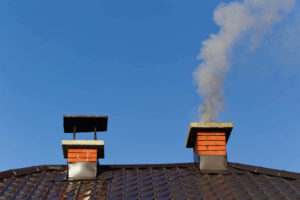How much do you need to know about your chimney system, as the homeowner? First-time homebuyers may have the hardest time adjusting to a chimney system because there is not a manual to explain it to them when you make your purchase. Oftentimes, the home inspection doesn’t even include a chimney inspection! It’s important to know your system, know the anatomy of your chimney, and to know it’s in good shape. Schedule a chimney inspection now to avoid any problems this winter, and to learn a little something from an expert.
Masonry Fireplaces
The masonry fireplace is an open system in which you light and burn a fire directly in the masonry firebox. As the area where most of the heat and abuse takes place, it should be built correctly with fire blocks protecting the masonry. Since the fireplace is open, the damper must be open while a fire is burning in order to vent harmful gases and smoke out of the house.
Masonry Chimneys
Your masonry chimney is built for the capacity of your fireplace. The shape, width, and length is designed specifically to vent the fireplace properly. It should have a liner that protects the masonry and keeps the fire and smoke in its place. The masonry is porous and can be damaged by weather and time, so the rest of the system should protect the masonry.
From Top to Bottom
The chimney cap keeps water, wind, and wildlife out of the flue. Caps can be designed to deflect wind, especially in regions of high-wind, and can even double as a damper when you choose a top sealing damper. The chimney crown is a cement ceiling that protects the rest of the chimney opening from weather. It is sloped for water runoff and hangs over the edge of the masonry to keep water from dripping down the side of the masonry. This crown, when constructed properly, should last with routine maintenance. Flaking, cracking, and deterioration can occur, but can be corrected with a professional crown repair.
You cannot see it, but your chimney has a smoke chamber that is also built specifically for your fireplace. The smoke chamber should be constructed with a certain slope and have a smooth surface to allow optimum airflow. The smoke shelf works to prevent backdraft in the chimney. Cold air falls to the smoke shelf and heats, causing it to rise back up the chimney. If water enters the chimney cap or crown, it can end up on the smoke shelf. If you hear dripping in your chimney system, but no water is visible, it is likely happening on the smoke shelf.
Your fireplace should be installed by a professional, and the chimney flue should be lined with an appropriately-sized liner.
If you’re still not sure what you’re looking at, it’s time to call an expert. Hiring a certified chimney sweep is the best way to get to know your system and take care of it year-round.
Call Chesapeake Chimney & Co. now and schedule your services. Call 410-535-0052.

Recent Comments